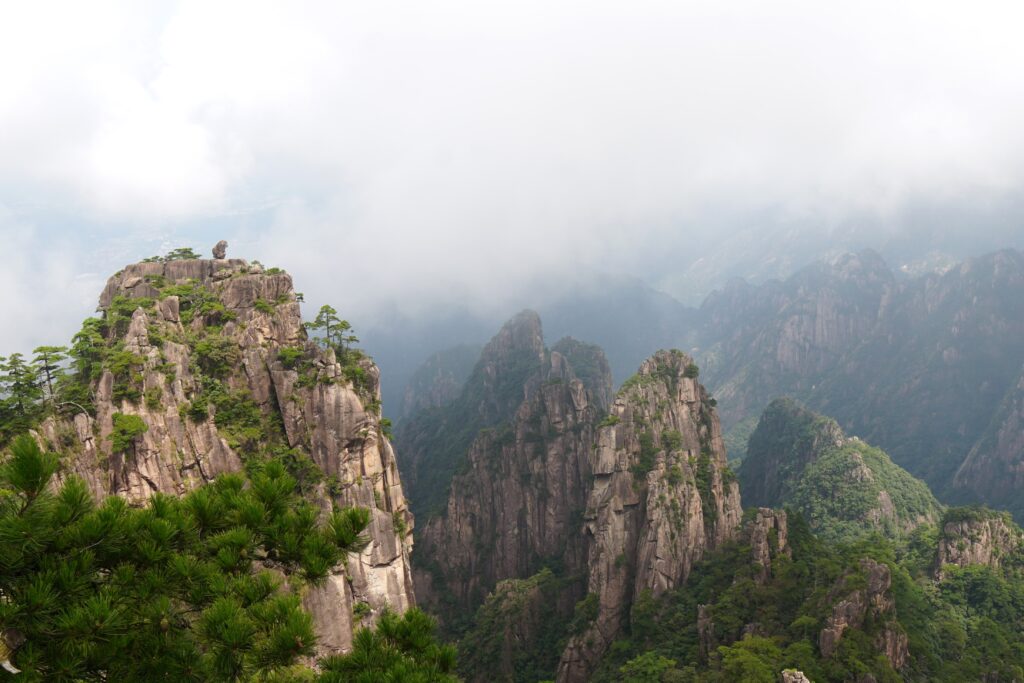It’s off to China again – this time to the picturesque mountainous region of Huangshan. Just a few hours by train from the bustling metropolises of Shanghai, Wuhan, Nanjing or Beijing, it’s the perfect place for a weekend getaway. If you’re heading to one of these cities and are looking for inspiration, a trip to one of China’s most stunning mountainous regions is highly recommended.
Today we’ll look at some of the main attractions in Huangshan, which are easy to explore over a weekend or a few days. And let’s not forget the local cuisine, which is a real treat in itself.
Just one warning: Some knowledge of Chinese will go a long way here, so consider having a translation app handy or opting for a guided tour for added convenience and safety.
Huangshan, also known as the Yellow Mountains, is an impressive mountain range in the eastern province of Anhui in China. It is characterised by its stunning natural beauty, with steep granite peaks, dense forests, mist-shrouded valleys, hot springs and picturesque sunrises and sunsets. Huangshan is also an important cultural and spiritual centre that has inspired artists, poets, writers and philosophers for centuries. It is considered one of the main sources of Chinese landscape painting. The region is also rich in historical sites and temples that reflect the rich history and culture of the area.
How to get to Huangshan?
- By plane: The nearest international airport is Huangshan Tunxi, located about 50 kilometres from Huangshan city centre. It is served by flights from various cities in China, including Beijing, Shanghai and Guangzhou. From there, you can get to Huangshan by bus, taxi or shuttle service.
- By (high-speed) train: There is Huangshanbei North Railway Station, which offers connections to Beijing, Shanghai, Hangzhou, Nanjing and other major Chinese cities in just a few hours. From the station it’s easy to get to Huangshan by public transport such as bus or taxi.
- By bus or car: buses and highways are also an option to reach Huangshan. However, this is only recommended if you’re already in Huangshan City and want to get to the mountains. Buses from more distant cities take longer. It is also not easy to get a driving licence in China (more information here).
Where to stay in Huangshan?
- Tangkou Town, at the foot of Huangshan Mountain, is a popular starting point for summit treks. The town has many hotels, guesthouses and inns offering affordable accommodation. Tangkou Town also features a wide range of restaurants and shops for travellers.
- Emerald Valley Scenic Area is a beautiful valley that meanders along the Emerald River and provides access to popular attractions such as Jiulong Waterfall. Located to the south-east of the Huangshan peaks, it has a selection of smaller hotels and apartments. As it’s much quieter and, in our opinion, more scenic than Tangkou Town, we opted for a hotel in this valley.
- There are several hotels and resorts close to the hot springs of Huangshan. These accommodations often offer wellness facilities such as thermal baths, spas and massages, and are a great way to unwind after a day of hiking in the mountains. Examples include the Xiangyuan Yungu Holiday Hotel, the Huangshan Qinman Resort Hotel and the Huangshan Lotus Hot Spring Hotel.
- You’ll also find a number of hotels and guesthouses on the peaks and trails of Huangshan. They often offer spectacular views and are perfect for enjoying the stunning mountain scenery early in the morning or in the evening when the day tourists have returned to the valley. Examples include the Xihai Hotel and the Beihai Hotel.
- Hongcun Village, a picturesque village near Huangshan, is also a popular place to stay. In this idyllic setting, numerous guesthouses and inns offer visitors a unique journey through the region’s rich history, architecture and culture
Off to the mountains! In order to climb the breathtaking mountain scenery of the Huangshan Mountains and its most famous peaks such as Lotus Peak (Lianhua Feng, 1,864 m), Bright Peak (Guangming Ding, 1,860 m) or Celestial Peak (Tiandu Feng, literally Capital of the Heavenly Summit, 1,829 m), there are several things to consider.
Firstly, there are different routes depending on the time available. The map below shows the most popular routes (the hotel owner marked our route in the map for our convenience):

You can also find more information about the different routes on chinahighlights.com and chinadiscovery.com, for example.
It’s best to enquire at your hotel or apartment, as operators often have extensive networks and can organise tickets, shuttle services, meals, etc. in advance.
If you prefer to organise everything yourself, visit one of the cable car stations on the day of your ascent. There you can buy both entrance and return tickets. Prices vary according to the season and the cable car you choose. During the high season from March to November, the cost of entrance and cable car is between 300 and 400 RMB (38-51 EUR) per person.
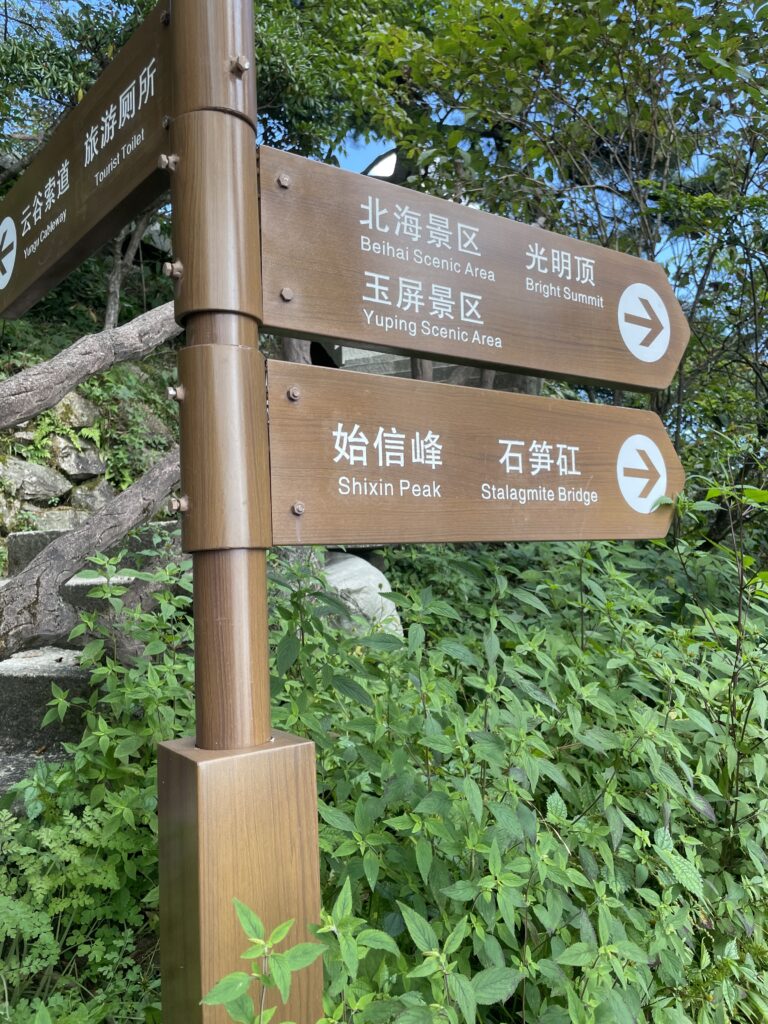
More tips for your visit:
- We recommend that you visit the mountains outside the main tourist season, as the trails can be very crowded, especially in May and October during the Chinese holidays.
- Bring warm clothing as it can get chilly above 1500m even in summer. Special equipment is not necessary as the trails are all well maintained and often paved.
- Bring plenty of food and water as the prices on the peaks are as high as the mountains themselves. It’s a good idea to stop at a cosy restaurant in the valley before or after the walk.
Here are some impressions of our tour. We leave our hotel early in the morning and are kindly driven to the South Gate by the owner. On arrival we show our passports and take the shuttle bus to the Yungu cable car station.

Now our ascent to the lofty heights begins! The view from the small gondolas is truly breathtaking and you can feel the majestic peaks coming closer and closer.
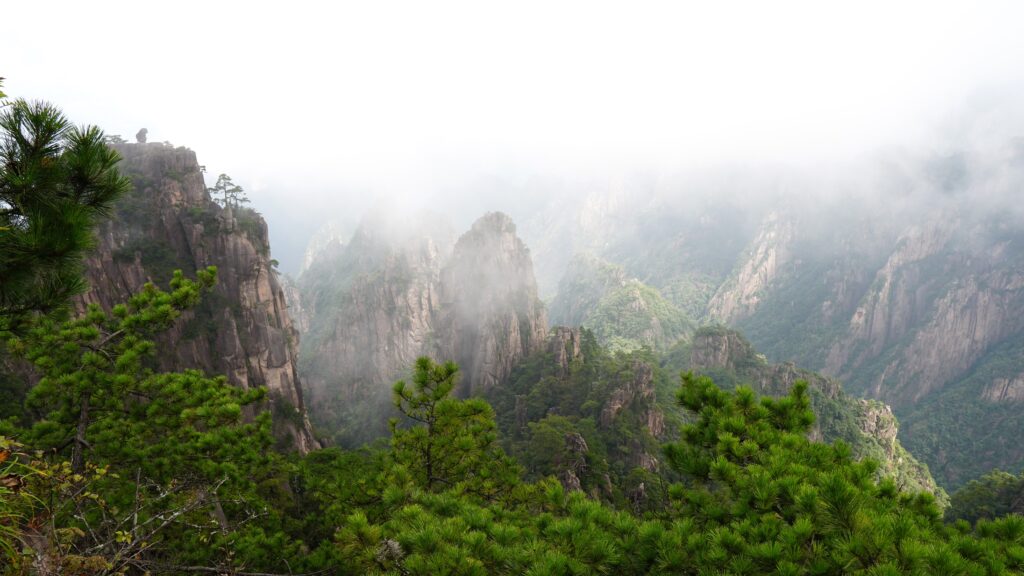
From the top station we start our walk past the Beihai Hotel to the „Stone Monkey watching the sea“ and to the „Lion Peak“.
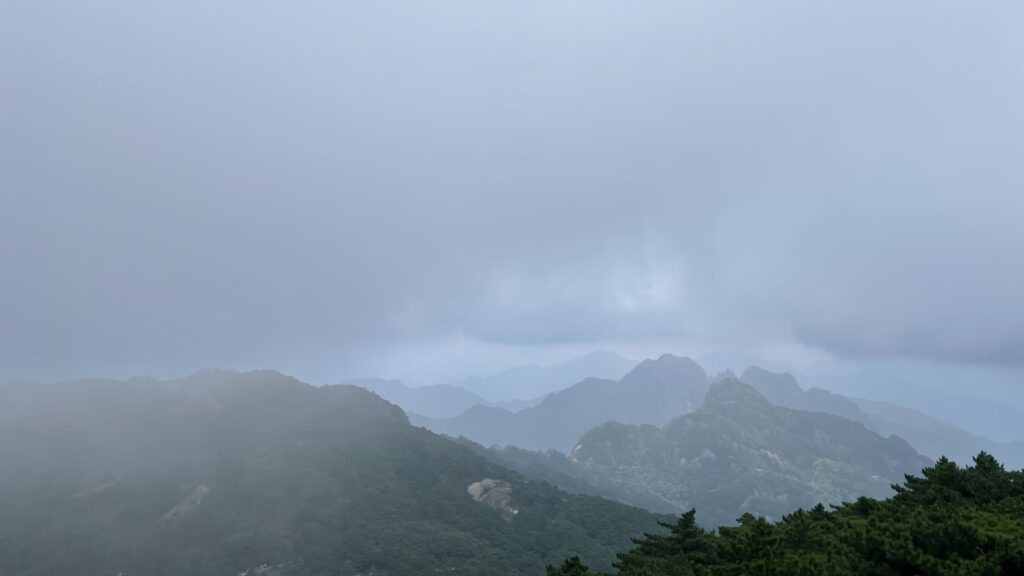

Our walk then takes us to „Bright Summit“ – be prepared for large crowds as this is a very popular viewpoint with tourists.

Past „Lotus Peak“ we continue to the Yuping Cable Car Station and down into the valley where our driver is waiting to take us back to the hotel.
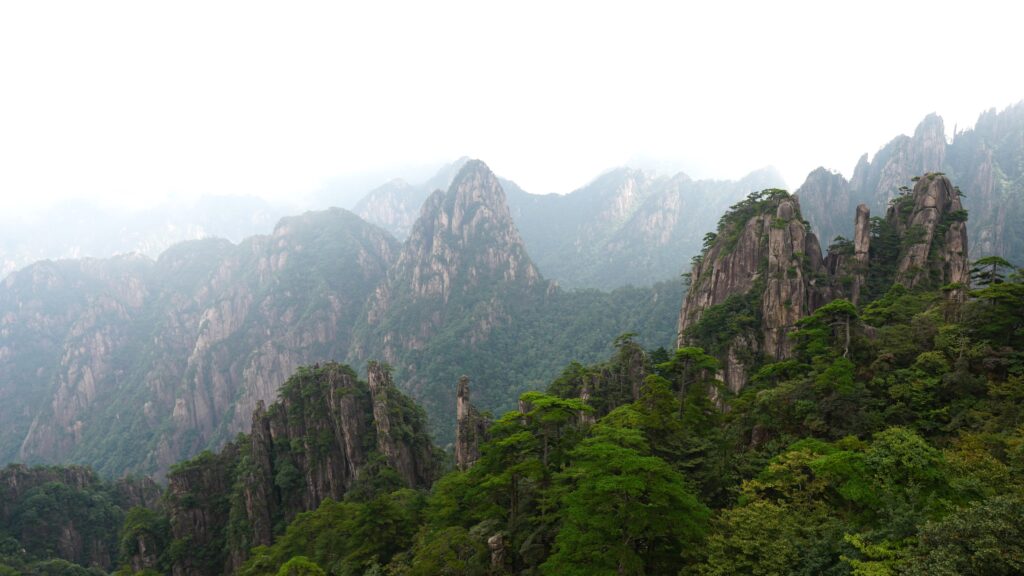
Let’s finish off with a quick visual tour of Huangshan Mountain, capturing some beautiful, tranquil moments. From rugged peaks piercing swirling mists to dramatic silhouettes against the sky, and ancient pines clinging to cliffs, every turn reveals stunning views of majesty and grace. Take in the ethereal sea of clouds, revealing endless hills and sheer cliffs bathed in golden sunlight







At the hotel, we enjoy delicious home-cooked meals prepared by the owner, who is a seasoned chef specialising in the regional cuisine of Huangshan and the southern Anhui region. Renowned for its distinctive flavours, Hui cuisine represents one of China’s esteemed eight regional culinary styles. It showcases the bounty of the mountains with its incorporation of locally-sourced, fresh ingredients, including wild herbs, mushrooms, bamboo shoots, and a diverse array of teas. The cuisine also makes the most of the region’s abundant resources, including its pristine rivers and lakes, with lots of tasty fish that has long been a cornerstone of its gastronomic heritage.
Characteristic of Hui cuisine is the smoking and marinating of meat and fish, as well as slow cooking and steaming to intensify flavours and retain nutrients. The use of fermented soybeans, soy sauce and other fermented products adds a rich umami flavour to the cuisine.
One classic dish is 黄山臭鳜鱼 (Huángshān chòu guìyú), also known as “Stinky Mandarin Fish from Huangshan“. The main ingredient is mandarin fish, a freshwater fish that’s pretty common in the rivers and lakes of the region. Before it’s prepared, the fish is fermented, which gives it its distinctive taste and tender texture. This fermentation process usually takes a few days and is carefully monitored to achieve the desired flavour.

Once the fish has been fermented, it is either fried in oil or steamed and then cooked in a spicy sauce. This sauce is made from fermented soybeans, garlic, ginger, chilli and other spices, which give the dish a really intense umami flavour.
We also ordered Huangshan Mao Doufu (黄山毛豆腐), a special type of fermented tofu and a traditional delicacy from the Huangshan region. The name literally translates to “hairy tofu” and refers to the distinctive appearance of this tofu, which forms a layer of edible mould during fermentation. This layer gives the tofu its unique appearance and a robust, slightly spicy flavour with a pronounced umami note. Tofu is either fried or steamed and served with various spices and toppings like minced garlic, spring onions, sesame seeds, fresh coriander leaves, or toasted sesame, which gives it a crispy outer layer and a soft interior.

The next dish, 野蕨菜, in English Bracken Fern, is an edible plant that grows mainly in the Huangshan Mountains. Also known as “黄山一绝” (a miracle of the Huangshan Mountains), the plant is renowned for its unique taste and health benefits.
The plant has a slightly bitter but refreshing taste. It is rich in vitamins and minerals, making it a highly nutritious ingredient.

The fern is sautéed in a pan and seasoned with a little garlic, salt and a dash of soy sauce. Red chilli peppers add pleasant heat and intensity to the dish.
Our final dish for tonight is Huangshan bamboo shoots stir-fried with meat (黄山笋干炒肉). It’s a traditional Chinese dish made from bamboo shoots, a special type of dried bamboo sprouts, and served with fried meat, tofu, and bell peppers or chili. These bamboo shoots come from the Huangshan region and have a chewy yet crisp texture with a unique, slightly sweet and earthy flavour. They are sliced or cut into strips and stir-fried together with the other ingredients. It’s a really balanced dish, with tasty pork, mild tofu, spicy peppers, and the aforementioned bamboo shoots.

I hope you have enjoyed this glimpse of some of China’s most beautiful scenery and a taste of the local food in Huangshan. But our journey to Huangshan isn’t over yet. Next time we’ll take you to the picturesque village of Hongcun. There we’ll explore some of the best sights and, as always, introduce you to the culinary delights on offer.

